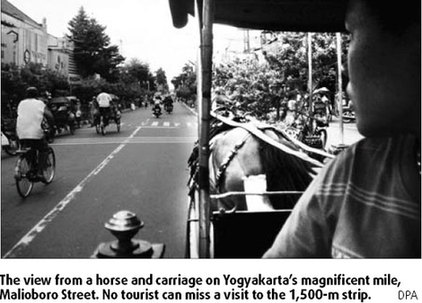Strolling along the 1,500-m strip of Yogyakarta's Malioboro Street is as essential as visiting Times Square when in New York City.
Tracing an imaginary line from the Sultan Palace on the south toward the peak of the legendary Merapi volcano to the north, the iconic street has been a bustling traditional market since 1758.
Yogyakarta is an ancient royal capital and one of the country's prime tourist destinations, abounding with cultural history, temples and a vibrant arts' and crafts' scene, and second only to Bali for visits by overseas tourists.
But the city, province and tourism industry were shattered by a pre-dawn earthquake, which flattened large areas and killed more than 5,800 people.
The May 27, 2006, magnitude-6.2 quake in the Central Java region damaged more than 350,000 homes and displaced 1.5 million people. Those figures would be astonishing except for the fact that the earthquake was anything but an isolated event for the country.
But now, the city seems to have bounced to its normal pulse, and Malioboro Street is the city's magnetic pole.
"I have to go to Malioboro when I visit Yogyakarta. I just have to," Ardian Ghani, 30, a visitor from Jakarta, says. "It's the exquisite atmosphere that you just can't explain."
About 800 m from the Sultan Palace, the famous Souvenirs Paradise street is framed by hundreds of shops, restaurants and historical landmarks. It once functioned as a rallying point against the Dutch.
Strolling on foot, one may soak in the sights, sounds and smells of vendors and their wares, ranging from local specialties such as batik, rattan ornament, leather puppets, bamboo and silver goods to general handicrafts.
Tourists can also take a ride in a pedicab or a horse-drawn cart for a cheap price.
Along the arcades, visitors may enjoy a leisurely shopping experience, but should follow the lead of the locals and bargain with the vendors for the best prices. The skilful haggler may be able to get the offered price halved and traders appreciate tourists who try to bargain in good faith and with good humor.
Near the end of the street, the famous Beringharjo market offers a full array of traditional products. In addition to local products of Yogyakarta, the market brims with other regional favorites, such as Pekalongan batik and Solo batik.
There are many choices of handmade batik, printed batik, window curtains with unique motifs and batik bed sheets. Adding to the local atmosphere, this traditional market offers great prices, too.
At one end of the street, tourists can drop in at the colonial Vredeburg Fort opposite Gedung Agung, an official presidential palace in the province. The fort was the Dutch bastion against attacks by Yogyakarta kingdom troops.
When the sun sets, the arcades transform into sprawling eateries featuring traditional "cross-legged" seating.
Enjoy a local specialty of Yogyakarta called Gudeg, a meal of sweetened jackfruit cooked in coconut milk as street troubadours serenade diners for gratuities.
(China Daily February 18, 2008)


